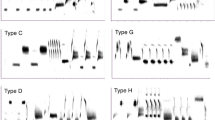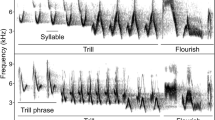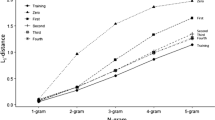Abstract
In an eastern population of song sparrows (Melospiza melodia), song type matching occurs at above chance levels but does not signal aggressiveness. One explanation for the apparent ineffectiveness of matching as a signal is that the occurrence of matching is constrained by internal rules for ordering the production of song types. This constraint hypothesis is tested here in an experiment in which the singing of territorial male song sparrows is monitored in the field in real time, and subjects are confronted with playback of one of their song types either immediately after switching away from that type (short-delay) or after having cycled through much of their repertoire since last singing that type (long-delay). Matching was not significantly more likely in the long-delay treatment than in the short-delay treatment. The probability of matching did, however, depend significantly on prior bout length: the longer was a singer’s last bout of a song type, the less likely the singer was to match it. There was also a suggestive effect of frequency of usage: males were more likely to match a song type the more frequently they normally sang that type, though this result was not significant after correcting for multiple comparisons. Thus, internal rules on how songs are sequenced exert constraints on the occurrence of song type matching, and such constraints can help to explain the apparent ineffectiveness of matching as a signal in this study population.
Significance statement
Research on song type matching in songbirds has largely focused on the signal function of matching, especially on the hypothesis that matching serves as an aggressive signal directed at the matched individual. In some songbirds, however, such as our study population of eastern song sparrows, predictions of the aggressive signaling hypothesis are not supported. Here, we show that the probability that song sparrows match song playback is strongly influenced by internal rules governing the sequencing of song type production. Specifically, the probability that song sparrows will match a particular song type is inversely related to the length of their prior bout of that song type. This result demonstrates how internal syntactical rules governing song type sequencing can constrain the signal function of song type matching.


Similar content being viewed by others
References
Akçay C, Tom ME, Holmes D, Campbell SE, Beecher MD (2011) Sing softly and carry a big stick: signals of aggressive intent in the song sparrow. Anim Behav 82:377–382
Akçay C, Tom ME, Campbell SE, Beecher MD (2013) Song type matching is an honest early threat signal in a hierarchical animal communication system. Proc R Soc B 280:20122517
Alves A, Antunes R, Bird A, Tyack PL, Miller PJO, Lam FPA, Kvadsheim PH (2014) Vocal matching of naval sonar signals by long-finned pilot whales (Globicephala melas). Mar Mammal Sci 30:1248–1257
Anderson RC, Searcy WA, Nowicki S (2005) Partial song matching in an eastern population of song sparrows, Melospiza melodia. Anim Behav 69:189–196
Anderson RC, Searcy WA, Nowicki S (2008) Testing the function of song-matching in birds: responses of eastern male song sparrows Melospiza melodia to partial song-matching. Behaviour 145:347–363
Arak A (1983) Vocal interactions, call matching and territoriality in a Sri Lankan treefrog, Philautus leucorhinus (Rhacophoridae). Anim Behav 31:292–302
Ballentine B, Hyman J, Nowicki S (2004) Vocal performance influences female response to male bird song: an experimental test. Behav Ecol 15:163–168
Balsby TJS, Bradbury JW (2009) Vocal matching by orange-fronted conures (Aratinga canicularis). Behav Process 82:133–139
Beecher MD, Campbell SE, Burt JM (1994) Song perception in the song sparrow: birds classify by song type but not by singer. Anim Behav 47:1343–1351
Beecher MD, Campbell SE, Burt JM, Hill CE, Nordby JC (2000a) Song-type matching between neighbouring song sparrows. Anim Behav 59:21–27
Beecher MD, Campbell SE, Nordby JC (2000b) Territory tenure in song sparrows is related to song sharing with neighbours, but not to repertoire size. Anim Behav 59:29–37
Bertram B (1970) The vocal behaviour of the Indian hill mynah, Gracula religiosa. Anim Behav Monogr 3:79–192
Berwick RC, Okanoya K, Beckers GJL, Bolhuis JJ (2011) Songs to syntax: the linguistics of birdsong. Trends Cogn Sci 15:113–121
Burt JM, Vehrencamp SL (2005) Dawn chorus as an interactive communication network. In: McGregor PK (ed) Animal communication networks. Cambridge University Press, Cambridge, pp 320–343
Burt JM, Campbell SE, Beecher MD (2001) Song type matching as threat: a test using interactive playback. Anim Behav 62:1163–1170
Burt JM, Bard SC, Campbell SE, Beecher MD (2002) Alternative forms of song matching in song sparrows. Anim Behav 63:1143–1151
Cassidy ALEV (1993) Song variation and learning in island populations of song sparrows. Dissertation, University of British Columbia
Catchpole CK, Slater PJB (2008) Bird song: biological themes and variations. Cambridge University Press, Cambridge
DuBois AL, Nowicki S, Searcy WA (2011) Discrimination of vocal performance by male swamp sparrows. Behav Ecol Sociobiol 65:717–726
DuBois AL, Nowicki S, Searcy WA (2016) A test for repertoire matching in eastern song sparrows. J Avian Biol 47:146–152
Falls JB (1985) Song matching in western meadowlarks. Can J Zool 63:2520–2524
Gammon DE, Hendrick MC, Baker MC (2008) Vocal communication in a songbird with a novel song repertoire. Behaviour 145:1003–1026
Gerhardt HC, Roberts JD, Bee MA, Schwartz JJ (2000) Call matching in the quacking frog (Crinia georgiana). Behav Ecol Sociobiol 48:243–251
Hedley RW (2016) Composition and sequential organization of song repertoires in Cassin’s Vireo (Vireo cassinii). J Ornithol 157:13–22
Hedley RW, Denton KK, Weiss RE (2017) Accounting for syntax in analyses of countersinging reveals hidden vocal dynamics in a songbird with a large repertoire. Anim Behav 131:23–32
Hinde RA (1958) Alternative motor patterns in chaffinch song. Anim Behav 6:211–218
Hughes M, Nowicki S, Searcy WA, Peters S (1998) Song-type sharing in song sparrows: implications for repertoire function and song learning. Behav Ecol Sociobiol 42:437–446
Hughes M, Anderson RC, Searcy WA, Bottensek LM, Nowicki S (2007) Song type sharing and territory tenure in eastern song sparrows: implications for the evolution of song repertoires. Anim Behav 73:701–710
Hurford JR (2012) The origins of grammar. Oxford University Press, Oxford
Hyman J, Hughes M, Searcy WA, Nowicki S (2004) Individual variation in the strength of territory defense in male song sparrows: correlates of age, territory tenure, and neighbor aggressiveness. Behaviour 141:15–27
Janik VM (2000) Whistle matching in wild bottlenose dolphins (Tursiops truncatus). Science 289:1355–1357
King SL, McGregor PK (2016) Vocal matching: the what, the why and the how. Biol Lett 12:20160666
Kramer HG, Lemon RE (1983) Dynamics of territorial singing between neighboring song sparrows (Melospiza melodia). Behaviour 85:198–223
Krebs JR (1976) Habituation and song repertoires in the great tit. Behav Ecol Sociobiol 1:215–227
Krebs JR, Ashcroft R, Van Orsdol K (1981) Song matching in the great tit Parus major L. Anim Behav 29:918–923
Kroodsma DE (1979) Vocal dueling among male marsh wrens: evidence for ritualized expressions of dominance/subordinance. Auk 96:506–515
Lapierre JM, Mennill DJ, MacDougall-Shackleton EA (2011) Spatial and age-related variation in use of locally common song elements in dawn singing of song sparrows Melospiza melodia: old males sing the hits. Behav Ecol Sociobiol 65:2149–2160
Liu IA, Soha JA, Nowicki S (2018) Song type matching and vocal performance in territorial signalling by male swamp sparrows. Anim Behav 139:117–125
Logue DM, Forstmeier W (2008) Constrained performance in a communication network: implications for the function of song-type matching and for the evolution of multiple ornaments. Am Nat 172:34–41
Miller PJO, Shapiro AD, Tyack PL, Solow AR (2004) Call-type matching in vocal exchanges of free-ranging resident killer whales, Orcinus orca. Anim Behav 67:1099–1107
Molles LE, Vehrencamp SL (2001) Songbird cheaters pay a retaliation cost: evidence for auditory conventional signals. Proc R Soc Lond B 268:2013–2019
Moseley DL, Lahti DC, Podos J (2013) Responses to song playback vary with the vocal performance of both signal senders and receivers. Proc R Soc B 280:20131401
Nowicki S, Searcy WA, Krueger T, Hughes M (2002) Individual variation in response to simulated territorial challenge among territory-holding song sparrows. J Avian Biol 33:253–259
Peters S, Searcy WA, Beecher MD, Nowicki S (2000) Geographic variation in the organization of song sparrow repertoires. Auk 117:936–942
Podos J (1996) Motor constraints on vocal development in a songbird. Anim Behav 51:1061–1070
Podos J (1997) A performance constraint on the evolution of trilled vocalizations in a songbird family (Passeriformes: Emberizidae). Evolution 51:537–551
Podos J, Peters S, Rudnicky T, Marler P, Nowicki S (1992) The organization of song repertoires in song sparrows: themes and variations. Ethology 90:89–106
Price JJ, Yuan DH (2011) Song-type sharing and matching in a bird with very large song repertoires, the tropical mockingbird. Behaviour 148:673–689
Rice WR (1989) Analyzing tables of statistical tests. Evolution 43:223–225
Rogers D (2004) Repertoire size, song sharing and type matching in the rufous bristlebird (Dasyornis broadbenti). Emu 104:7–13
Schroeder DJ, Wiley RH (1983) Communication with shared song themes in tufted titmice. Auk 100:414–424
Searcy WA, Beecher MD (2009) Song as an aggressive signal in songbirds. Anim Behav 78:1281–1292
Searcy WA, McArthur PD, Peters SS, Marler P (1981) Response of male song and swamp sparrows to neighbour, stranger, and self songs. Behaviour 77:152–163
Searcy WA, McArthur PD, Yasukawa K (1985) Song repertoire size and male quality in song sparrows. Condor 87:222–228
Searcy WA, Podos J, Peters S, Nowicki S (1995) Discrimination of song types and variants in song sparrows. Anim Behav 49:1219–1226
Searcy WA, Nowicki S, Peters S (1999) Song types as fundamental units in vocal repertoires. Anim Behav 58:37–44
Searcy WA, Nowicki S, Hogan C (2000) Song type variants and aggressive context. Behav Ecol Sociobiol 48:358–363
Searcy WA, Anderson RC, Nowicki S (2006) Bird song as a signal of aggressive intent. Behav Ecol Sociobiol 60:234–241
Searcy WA, DuBois AL, Rivera-Cáceres K, Nowicki S (2013) A test of a hierarchical signalling model in song sparrows. Anim Behav 86:309–315
Searcy WA, Akçay C, Nowicki S, Beecher MD (2014) Aggressive signaling in song sparrows and other songbirds. Adv Study Behav 46:89–125
Stoddard PK, Beecher MD, Campbell SE, Horning CL (1992) Song-type matching in the song sparrow. Can J Zool 70:1440–1444
Sugiura H (1998) Matching of acoustic features during the vocal exchange of coo calls by Japanese macaques. Anim Behav 55:673–687
Suzuki TN, Wheatcroft D, Griesser M (2016) Experimental evidence for compositional syntax in bird calls. Nat Commun 7:10986
Suzuki TN, Griesser M, Wheatcroft D (2019) Syntactic rules in avian vocal sequences as a window into the evolution of compositionality. Anim Behav 151:267–274
Templeton CN, Ríos-Chelén AA, Quirós-Guerrero E, Mann NI, Slater PJB (2012) Female happy wrens select songs to cooperate with their mates rather than confront intruders. Biol Lett 9:20120863
Tinbergen N (1963) On aims and methods of ethology. Z Tierpsychol 20:410–433
Todt D (1971) Äquivalente und konvalente gesangliche Reaktionen einer extrem regelmässig singenden Nachtigall (Luscinia megarhynchos L.). Z Vergl Physiol 71:262–285
Todt D (1981) On functions of vocal matching: effects of counter-replies on song post choice and singing. Z Tierpsychol 57:73–93
Vehrencamp SL (2001) Is song-type matching a conventional signal of aggressive intentions? Proc R Soc Lond B 268:1637–1642
Verner J (1975) Complex song repertoire of male long-billed marsh wrens in eastern Washington. Living Bird 14:263–300
Whitney CL (1985) Serial order in wood thrush song. Anim Behav 33:1250–1265
Acknowledgments
We thank Cori Richards-Zawacki and the staff of the University of Pittsburgh’s Pymatuning Laboratory of Ecology for logistical support and the Pennsylvania Game Commission for access to study sites. We thank the Associate Editor and two anonymous reviewers for their comments. We are grateful to Susan Peters for performing the independent judging of song type matching and to Karla Rivera-Cáceres for help with the GLMMs.
Funding
Financial support was provided by the Robert E. Maytag Research Fund of the University of Miami and the Duke University Office of the Provost.
Author information
Authors and Affiliations
Corresponding author
Ethics declarations
Conflict of interest
The authors declare that they have no conflict of interest.
Ethical approval
All procedures used in this study were approved by the Institutional Animal Care and Use Committees of the University of Miami (protocol no. 17–046), Duke University (protocol no. A004-17-01) and the University of Pittsburgh (protocol no. 15045539). All applicable national and institutional guidelines for the use of animals were followed. Playback trials were kept brief (≤3 min) to minimize disturbance to our subjects.
Additional information
Communicated by J. Podos
Publisher’s note
Springer Nature remains neutral with regard to jurisdictional claims in published maps and institutional affiliations.
Rights and permissions
About this article
Cite this article
Searcy, W.A., Ocampo, D. & Nowicki, S. Constraints on song type matching in a songbird. Behav Ecol Sociobiol 73, 102 (2019). https://doi.org/10.1007/s00265-019-2708-6
Received:
Revised:
Accepted:
Published:
DOI: https://doi.org/10.1007/s00265-019-2708-6




